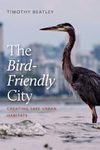About this book
This handbook provides a state-of-the-art, comprehensive overview of the expanding field of urban biodiversity.
The field of urban biodiversity has emerged from within the broad discipline of urban ecology in the past two decades and is now a significant field in its own right. In view of this, the Routledge Handbook of Urban Biodiversity presents a thorough treatment of this field detailing the history of urban biodiversity, theoretical foundations, current state of knowledge, and application of that knowledge. The handbook is split into four parts:
Part I: Setting the Stage for Urban Biodiversity Research and Practice
Part II: Foundational Concepts and Theory in Urban Biodiversity Research
Part III: Population and Community Ecology of Key Urban Taxa
Part IV: Urban Biodiversity Practice: Management, Planning, and Design for Healthy Communities
This volume contains interdisciplinary and global contributions from established and early career academics as well as professionals and practitioners, addressing two key fields in urban biodiversity: fundamental research focused on answering questions about the mechanisms explaining the distribution of species among and within cities; and applied research and work by practitioners to address concerns about urban biodiversity conservation, restoration, planning, design, and public involvement.
This handbook is essential reading for students, academics, and professionals interested and working in the fields of urban biodiversity, ecology, nature conservation, urban planning, and landscape architecture.
Contents
1. Introduction to the Routledge Handbook of Urban Biodiversity / Charles H. Nilon and Myla F.J. Aronson
Part 1: Setting the stage for urban biodiversity research and practice
2. History of urban biodiversity research and practice / Charles H. Nilon
3. Comparative urban ecology and the gradient approach: extending knowledge by acknowledging the diversity of cities around the world / Amy K. Hahs
4. Urban climate and the biophysical environment / Peter Ibsen, Dion Kucera, Stephanie Piper, and G. Darrel Jenerette
5. Understanding land use, land cover, and landscape patterns of the world’s cities for sustainable biodiversity planning / Cynnamon Dobbs, Dagmar Haase, and Ulla Mörtberg
Part 2: Foundational concepts and theory in urban biodiversity research
6. The application of landscape ecology and biogeography in the study of urban biodiversity / Christopher A. Lepczyk and Frank A. La Sorte
7. Community assembly and filtering of urban ecosystems / Myla F.J. Aronson, Christopher A. Lepczyk, and Karl L. Evans
8. From filters to feedbacks: how do people influence biodiversity across scales? / Riley Andrade, Paige S. Warren, and Sarel S. Cilliers
9. People’s decisions shape urban habitats / Dave Kendal, Emily Minor, and Monika Egerer
10. Scaling-up the management and conservation of urban biodiversity / Susannah B. Lerman, Josep Padullés Cubino, and Mark A. Goddard
11. Connecting biodiversity and human wellbeing / Jessica C. Fisher, Maximilian Nawrath, Martin Dallimer, Katherine N. Irvine, and Zoe G. Davies
12. ultidimensionality of biodiversity in urban social-ecological soil systems / Loren B. Byrne and Katalin Szlavecz
13. Plant invasions in cities: patterns, processes, consequences, and management / Mirijam Gaertner and Ingo Kowarik
14. The importance of citizen science for understanding urban biodiversity / Christopher A. Lepczyk and Timothy Vargo
Part 3: Population and community ecology of key urban taxa
15. Patterns and drivers of plant biodiversity in urban and urbanizing landscapes / Sonja Knapp and Wayne Zipperer
16. Urbanization shapes insect diversity / Emily K. Meineke, Elsa Youngsteadt, Mia K. Lippey, and Katherine C.R. Baldock
17. Birds in an urban world: community patterns across cities / Christine Rega-Brodsky and Ian MacGregor-Fors
18. A cross-continental synthesis of urban insectivorous bat research and future directions / Caragh G. Threlfall and Kirsten Jung
19. Impacts of urbanization on amphibians and opportunities for their conservation in cities / Kirsten M. Parris
20. Freshwater biodiversity in urban ecosystems / Augustin C. Engman and Allison H. Roy
Part 4: Urban biodiversity practice: management, planning, and design for healthy communities
21. Urban green infrastructure, biodiversity, poverty, and equity / Charlie M. Shackleton
22. Managing vegetation for urban biodiversity / Jun Yang, Sonja Knapp, and Wayne Zipperer
23. The role of engineered green infrastructure in supporting urban biodiversity / J. Scott MacIvor, Nicholas S.G. Williams, and Jeremy Lundholm
24. Global biodiversity requires integrating social and ecological goals for urban biodiversity: insights from ecological restoration / Lea R. Johnson
25. Cities are planning for biodiversity: a global survey of city plans / Karen M. O’Neill, Myla F.J. Aronson, Charles H. Nilon, Sarel S. Cilliers, Cynnamon Dobbs, Laren J. Frazee, Mark A. Goddard, Debra Roberts, Emilie K. Stander, Peter Werner, and Ken P. Yocom
26. Development and evolution of urban biodiversity indicators and assessment tools / Yuta Uchiyama and Ryo Kohsaka
27. Urban biodiversity: opportunities and challenges in the Paris Region / Marc Barra
28. Regeneration of urban nature: from planning to action / Diana Wiesner
29. Design for urban biodiversity: applying research on biodiversity of urban lawns into landscape design practice / Maria Ignatieva
Customer Reviews
Biography
Charles H. Nilon is a professor in the School of Natural Resources at the University of Missouri. His research and teaching focus on urban wildlife conservation, urban ecology, and the human dimensions of wildlife conservation. Dr. Nilon is a co-director of three urban biodiversity synthesis projects, including the "Urban Biodiversity Research Coordination Network" (UrBioNet), and is co-president of the International Urban Biodiversity and Design Network (URBIO).
Myla F.J. Aronson is an assistant professor in the Department of Ecology, Evolution, and Natural Resources, at Rutgers, The State University of New Jersey. Her research and teaching focuses on the patterns, drivers, and management of biodiversity in human dominated landscapes, particularly plant population and community dynamics in urban areas. Dr. Aronson is co-director of three urban biodiversity synthesis projects, including the "Urban Biodiversity Research Coordination Network" (UrBioNet), and serves on the Advisory Board for the International Urban Biodiversity and Design Network (URBIO).


































